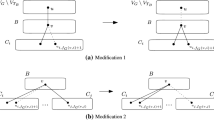Abstract
The mirror (or bipartite complement) \({{\mathrm{mir}}}(B)\) of a bipartite graph \(B=(X,Y,E)\) has the same color classes \(X\) and \(Y\) as \(B\), and two vertices \(x \in X\) and \(y \in Y\) are adjacent in \({{\mathrm{mir}}}(B)\) if and only if \(xy \notin E\). A bipartite graph is chordal bipartite if none of its induced subgraphs is a chordless cycle with at least six vertices. In this paper, we deal with chordal bipartite graphs whose mirror is chordal bipartite as well; we call these graphs auto-chordal bipartite graphs (ACB graphs for short). We characterize ACB graphs, show that ACB graphs have unbounded bipartite Dilworth number, and we characterize ACB graphs with bipartite Dilworth number \(k\).


Similar content being viewed by others
References
Benzaken, C., Hammer, P.L., de Werra, D.: Split graphs of Dilworth number 2. Discrete Mathematics 55, 123–127 (1985)
Berry, A., Sigayret, A.: Dismantlable lattices in the mirror. In: Cellier, P., Distel, F., Ganter, B. (eds.) Proceedings of ICFCA’13, LNAI 7880, pp. 44–59. Springer, Heidelberg (2013)
Berry, A., Brandstädt, A., Engel, K.: The Dilworth number of auto-chordal-bipartite graphs. arXiv:1309.5787vl (2013)
Brandstädt, A., Le, V.B., Spinrad, J.P.: Graph Classes: A Survey. SIAM Monographs on Discrete Math. Appl. SIAM, Philadelphia (1999)
Chvátal, V., Hammer, P.L.: Aggregation of inequalities in integer programming. Annals Discrete Mathematics 1, 145–162 (1977)
Dahlhaus, E.: Chordale Graphen im besonderen Hinblick auf parallele Algorithmen. Habilitation Thesis, Universität Bonn (unpublished) (1991)
Földes, S., Hammer, P.L.: Split graphs. Congr. Numer. 19, 311–315 (1977)
Földes, S., Hammer, P.L.: Split graphs having Dilworth number 2. Canadian J. Math. 29, 666–672 (1977)
Golumbic, M.C., Goss, C.F.: Perfect elimination and chordal bipartite graphs. JGT 2, 155–163 (1978)
Korpelainen, N., Lozin, V.V., Mayhill, C.: Split permutation graphs. Graphs and Combinatorics 30, 633–646 (2014)
Lubiw, A.: Doubly lexical orderings of matrices. SIAM J. Comput. 16, 854–879 (1987)
Nara, C.: Split graphs with Dilworth number three. Natural Science Report of the Ochanomizu University. 33(1/2), 37–44 (unpublished, available online) (1982)
Paige, R., Tarjan, R.E.: Three partition refinement algorithms. SIAM J. Comput. 16, 973–989 (1987)
Spinrad, J.P.: Efficient graph representations, Fields Institute Monographs, vol.19. AMS, Providence (2003)
Spinrad, J.P.: Doubly lexical ordering of dense 0–1 matrices. IPL 45, 229–235 (1993)
Yannakakis, M.: The complexity of the partial order dimension problem. SIAM J. Alg. Discr. Meth. 3, 351–358 (1982)
Acknowledgments
We are grateful to Van Bang Le for an interesting discussion leading to a simplified structure of the graphs \(D_k\).
Author information
Authors and Affiliations
Corresponding author
Rights and permissions
About this article
Cite this article
Berry, A., Brandstädt, A. & Engel, K. The Dilworth Number of Auto-Chordal Bipartite Graphs. Graphs and Combinatorics 31, 1463–1471 (2015). https://doi.org/10.1007/s00373-014-1471-8
Received:
Revised:
Published:
Issue Date:
DOI: https://doi.org/10.1007/s00373-014-1471-8




